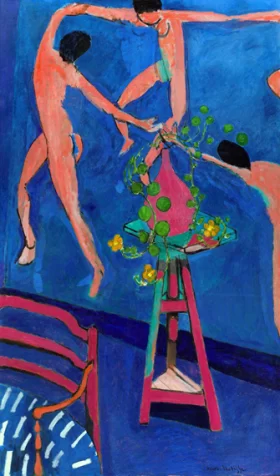5% Off Sitewide | Use code KMUS5 on checkout
- Choose your Country
5% Off Sitewide | Use code KMUS5 on checkout
Fauvism
The Fauvism art movement, which emerged in the early 20th century, was a radical departure from traditional approaches to painting. Led by a group of avant-garde artists including Henri Matisse, André Derain, and Raoul Dufy, Fauvism introduced a bold and vibrant style characterized by vivid colors, expressive brushwork, and a disregard for naturalistic representation. The movement, named after the French word “les fauves” meaning “wild beasts,” shocked the art world with its audacious use of color and marked a pivotal moment in the development of modern art.
Fauvism was a reaction against the restrained palette and academic conventions of the late 19th century. Fauvist artists sought to break free from the confines of realistic representation and explore the expressive potential of color. They rejected the notion that art should imitate nature faithfully, instead prioritizing emotional and aesthetic impact. Fauvism was characterized by its bold, non-naturalistic use of color, where artists employed intense and arbitrary hues to convey subjective responses to the world around them.
The Fauvists drew inspiration from various sources, including Post-Impressionism and the works of Vincent van Gogh, Paul Gauguin, and Paul Cézanne. They were particularly influenced by the strong use of color and expressive brushwork found in these artists’ works. The Fauvists sought to capture the essence of a subject by distilling its emotional impact through color and form.
Henri Matisse, one of the leading figures of Fauvism, played a pivotal role in shaping the movement. His bold use of color and simplified forms became hallmarks of Fauvist style. Matisse believed that color had the power to evoke emotions and express the artist’s inner world. His paintings such as “The Joy of Life” and “Woman with a Hat” exemplify the Fauvist aesthetic with their vibrant and arbitrary color choices, energetic brushwork, and flattened perspective.
André Derain, another prominent Fauvist artist, developed his own unique style within the movement. Derain’s works often showcased the juxtaposition of complementary colors and emphasized the structural elements of a composition. His paintings such as “Charing Cross Bridge” and “The Dance” exhibit a dynamic interplay of color and form, conveying a sense of movement and energy.
The Fauvists held their first exhibition in Paris in 1905, which caused a sensation and sparked both admiration and controversy. Critics and the public were taken aback by the audacity and seemingly chaotic nature of the Fauvist works. Art critic Louis Vauxcelles famously coined the term “les fauves” to describe the artists’ untamed and wild use of color. Although the movement was met with mixed reviews, Fauvism laid the groundwork for future artistic developments and challenged the established norms of the art world.
One of the significant contributions of Fauvism was its impact on color theory. The Fauvists rejected the traditional notion of color as a tool for representing reality and instead explored the emotional and expressive potential of color. Their use of vibrant, non-naturalistic colors created a visual impact that extended beyond the representational aspect of the artwork. Fauvist artists embraced the autonomy of color and its ability to evoke mood and sensations.
The influence of Fauvism extended beyond painting and had an impact on sculpture, graphic arts, and even architecture. Fauvist principles, such as the expressive use of color and the rejection of naturalistic representation, found resonance in other art forms. Fauvist ideas also influenced subsequent movements, such as German Expressionism and Abstract Expressionism, which further explored the emotive and subjective aspects of art.
As the years went by, the Fauvist movement gradually dissolved as its artists ventured into new artistic territories. Henri Matisse, for example, moved towards a more decorative and refined style, while André Derain explored other artistic approaches. However, the influence of Fauvism remained significant, as it challenged conventional notions of color, form, and representation.
In conclusion, Fauvism was a groundbreaking art movement that defied traditional artistic conventions and embraced the bold and expressive use of color. Led by artists such as Henri Matisse and André Derain, the Fauvists sought to convey emotion, sensation, and individual perception through their vibrant and arbitrary color choices. The movement marked a significant shift in the trajectory of modern art and laid the foundation for future artistic developments. Fauvism’s impact on color theory and its exploration of the emotional power of color continue to inspire and resonate with artists and viewers today.
Read moreShowing 1–100 of 944 results

Big Ben 1906
By André DerainSizes starting at $359.00
Odalisque Couchée Aux Magnolias
By Henri MatisseSizes starting at $329.00
Charing Cross Bridge
By André DerainSizes starting at $339.00
L’Odalisque, harmonie bleue
By Henri MatisseSizes starting at $319.00
La Tamise au pont de Westminster
By André DerainSizes starting at $339.00
Purple Robe and Anemones
By Henri MatisseSizes starting at $309.00
The Palace of Westminster
By André DerainSizes starting at $339.00
Woman in a Purple Coat
By Henri MatisseSizes starting at $319.00
Waterloo Bridge
By André DerainSizes starting at $339.00
Woman with a Hat (Femme au chapeau)
By Henri MatisseSizes starting at $329.00
Les voiles rouges (The Red Sails)
By André DerainSizes starting at $339.00
The open window
By Henri MatisseSizes starting at $309.00
La glace sans tain (The Blue Window)
By Henri MatisseSizes starting at $349.00
Woman in chemise
By André DerainSizes starting at $339.00
Les poissons rouges (Interior with a Goldfish Bowl)
By Henri MatisseSizes starting at $349.00
Madame Matisse in a Kimono
By André DerainSizes starting at $339.00
The Joy Of Life (Le Bonheur De Vivre)
By Henri MatisseSizes starting at $319.00
The Turning Road L’Estaque
By André DerainSizes starting at $409.00
Boats at Collioure
By André DerainSizes starting at $339.00
Luxe, Calme, et Volupté (Luxury, Calm, and Desire)
By Henri MatisseSizes starting at $329.00
Londres, Westminster
By André DerainSizes starting at $369.00
The Red Studio
By Henri MatisseSizes starting at $289.00
La danse
By Henri MatisseSizes starting at $309.00
Les Deux Péniches
By André DerainSizes starting at $339.00
Blackfriars Bridge, London
By André DerainSizes starting at $359.00
Dance (I)
By Henri MatisseSizes starting at $329.00
Charing Cross Bridge, London
By André DerainSizes starting at $339.00
Music
By Henri MatisseSizes starting at $309.00
Charing Cross Bridge, London
By André DerainSizes starting at $369.00
Les Capucines (Nasturtiums with The Dance II)
By Henri MatisseSizes starting at $339.00
Charing Cross Bridge
By André DerainSizes starting at $339.00
La Leçon de piano
By Henri MatisseSizes starting at $339.00
Les Quais de la Tamise
By André DerainSizes starting at $339.00
Pianist and Checker Players
By Henri MatisseSizes starting at $339.00
Dancer on a Chair – Danseuse Dans le Fauteuil, Sol en Damier
By Henri MatisseSizes starting at $329.00
London Bridge
By André DerainSizes starting at $409.00
Jeune fille aux anémones sur fond violet
By Henri MatisseSizes starting at $309.00
St. Paul’s Cathedral seen from the Thames
By André DerainSizes starting at $339.00
Goldfish
By Henri MatisseSizes starting at $349.00
Londres- Le Quai Victoria
By André DerainSizes starting at $389.00
Cat With Red Fish (Chat Aux Poissons Rouges)
By Henri MatisseSizes starting at $319.00
The Pool of London
By André DerainSizes starting at $409.00
Les arbres (The Trees)
By André DerainSizes starting at $339.00
Portrait of Madame Matisse. The Green Line
By Henri MatisseSizes starting at $319.00
Bathers by a River
By Henri MatisseSizes starting at $329.00
Mountains at Collioure
By André DerainSizes starting at $339.00
Vue de Collioure (View of Collioure)
By André DerainSizes starting at $369.00
Woman In Green Gown (La Femme en jaune)
By Henri MatisseSizes starting at $319.00
Arbres à Collioure
By André DerainSizes starting at $339.00
Boléro violet
By Henri MatisseSizes starting at $379.00
Portrait au manteau bleu
By Henri MatisseSizes starting at $349.00
The Sunken Path Lestaque
By André DerainSizes starting at $339.00
Environs de Collioure
By André DerainSizes starting at $339.00
Espagnole
By Henri MatisseSizes starting at $349.00
Femme à l’ombrelle
By Henri MatisseSizes starting at $319.00
Trees In The Morning Light
By André DerainSizes starting at $329.00
Bateaux à Collioure
By André DerainSizes starting at $339.00
Femme au chapeau
By Henri MatisseSizes starting at $339.00
Bateaux dans le Port de Collioure
By André DerainSizes starting at $349.00
Titine Trovato en robe et chapeau
By Henri MatisseSizes starting at $309.00
Fishing Boats, Collioure
By André DerainSizes starting at $339.00
Red Madras Headdress (Le Madras rouge)
By Henri MatisseSizes starting at $319.00
Anémones et grenades
By Henri MatisseSizes starting at $279.00
Drying the Sails
By André DerainSizes starting at $339.00
Fishing boats Collioure
By André DerainSizes starting at $339.00
Interiéur à Nice, femme assise avec un livre
By Henri MatisseSizes starting at $319.00
Barques au port de Collioure
By André DerainSizes starting at $339.00
La Séance du matin
By Henri MatisseSizes starting at $289.00
Bateaux sur la plage à Collioure
By André DerainSizes starting at $369.00
Bouquet de fleurs pour le Quatorze Juillet
By Henri MatisseSizes starting at $289.00
Boats at Collioure
By André DerainSizes starting at $339.00
The Piano Lesson
By Henri MatisseSizes starting at $279.00
Bateau sur La Seine, environs de Paris
By André DerainSizes starting at $339.00
Woman with a Veil
By Henri MatisseSizes starting at $299.00
Bridge over the Riou
By André DerainSizes starting at $339.00
Goldfish and Palette
By Henri MatisseSizes starting at $289.00
Black Mirror Anemones (Anémones Au Miroir Noir)
By Henri MatisseSizes starting at $279.00
Boats in Chatou
By André DerainSizes starting at $389.00
Nature morte aux trois vases
By Henri MatisseSizes starting at $279.00
Regent Street London 1906
By André DerainSizes starting at $409.00
Red Room
By Henri MatisseSizes starting at $279.00
The Bridge at Le Pecq
By André DerainSizes starting at $349.00
Bateaux au Port de Collioure
By André DerainSizes starting at $329.00
The Conversation
By Henri MatisseSizes starting at $289.00
Le port de Collioure
By André DerainSizes starting at $369.00
Still Life with Pineapple
By Henri MatisseSizes starting at $269.00
Le Faubourg de Collioure
By André DerainSizes starting at $339.00
The Snail (L’Escargot)
By Henri MatisseSizes starting at $249.00
Collioure
By André DerainSizes starting at $359.00
Mlle. Matisse en manteau écossais
By Henri MatisseSizes starting at $309.00
Le phare de Collioure
By André DerainSizes starting at $339.00
Yellow Odalisque
By Henri MatisseSizes starting at $309.00
Bords de rivière
By André DerainSizes starting at $359.00
Young Girl In A Green Dress (Jeune fille à la mauresque, robe verte )
By Henri MatisseSizes starting at $309.00
Algerian Woman
By Henri MatisseSizes starting at $319.00
Landscape
By André DerainSizes starting at $439.00
Hyde Park
By André DerainSizes starting at $399.00
Portrait aux cheveux bouclés, pull marin (Allan Stein)
By Henri MatisseSizes starting at $309.00
La fenêtre ouverte
By Henri MatisseSizes starting at $279.00
The Dance
By André DerainSizes starting at $369.00




































































































